Raytheon (Texas Instruments) Paveway II
(GBU-10/B, GBU-12/B, GBU-16/B, GBU-17/B, GBU-48/B, GBU-49/B,
GBU-50/B, GBU-51/B, GBU-52/B, GBU-58/B, GBU-59/B, GBU-73/B)
History and General Description
The Paveway I laser-guided bombs had been used by the USAF very successfully in the later phases of the Vietnam war. The Paveway II follow-on development rectified two major shortcomings of the first version: the Computer Control Group (CCG) was significantly simpler and therefore cheaper, and the fixed tailfins were replaced by foldable ones. The latter feature combined the advantages of both the "long wing" and "short wing" versions of the Paveway I airfoil groups - high speed delivery and long stand-off range. It also allowed for easier ground handling and more compact storage and carriage. Prototype testing of Paveway II guidance kits started in 1974, and production began in 1977.
Paveway II guidance kits were produced for the 2000 lb class MK 84 and BLU-109/B, the 1000 lb MK 83 and the 500 lb MK 82 bombs (see Variants section below for a detailed rundown of all versions). Including foreign sales, more than 100000 Paveway II kits have been built, and production and upgrades are still continuing. The primary manufacturer for Paveway II is Raytheon, building the MAU-169( )/B series of CCGs. In the early 2000s, Lockheed Martin established itself as a second source, and currently produces the MAU-209( )/B CCG, which is interchangeable with the MAU-169( )/B. The current version of the MAU-209 is the MAU-209B/B, which has completely replaced the original MAU-209/B.
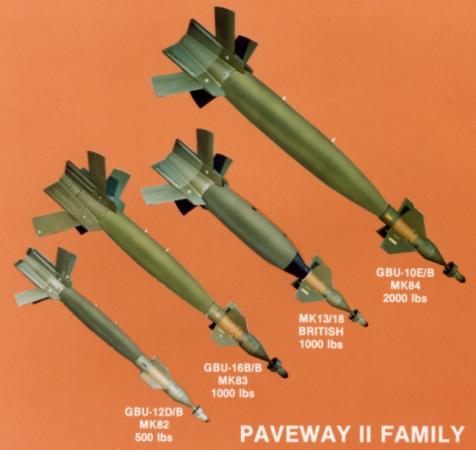 |
| Photo: Texas Instruments |
| Paveway II family (GBU-10E/B, GBU-12D/B, GBU-16B/B) |
In good conditions, a Paveway II LGB has an accuracy of about 6 m (20 ft) CEP. However, laser guidance doesn't work very well in bad weather, and when the illuminating laser is switched off for any reason, guidance is completely lost. To overcome these shortcomings, a GPS-aided inertial add-on package for Paveway II LGBs was developed (as was done for Paveway III). GPS/INS-enabled LGBs are frequently referred to as EGBUs (E = Enhanced). So far, Raytheon-built Paveway II EGBUs have primarily been produced for export, and have already been used in combat by the British Royal Air Force over Afghanistan and Iraq.
Lockheed Martin has developed its DMLGB (Dual-Mode LGB) GPS/INS upgrade for Paveway II, and in November 2005, the company received a U.S. Navy contract for further development and eventual production of DMLGB kits to upgrade the Navy's Paveway II stockpile. Primary focus is on the 500 lb GBU-12/B series, but the 1000 lb GBU-16/B and 2000 lb GBU-10/B are planned to follow.
Variants
GBU-10/B, GBU-50/B
The GBU-10/B series covers Paveway I and Paveway II LGBs with warheads in the 2000 lb class. The following warheads are used in GBU-10/B series LGBs:
- MK 84: Standard 2000 lb LDGP (Low-Drag General Purpose) bomb
- BLU-109/B: 2000 lb class penetrator warhead
- BLU-117/B: In place of the MK 84, the U.S. Navy also uses the BLU-117/B warhead. The BLU-117/B is externally identical to the MK 84, but uses the PBXN-109 thermally insensitive explosive and has external protective coating.
The designation GBU-50/B covers Raytheon Enhanced Paveway II GPS/INS-equipped GBU-10/B variants, which are informally also known as EGBU-10.
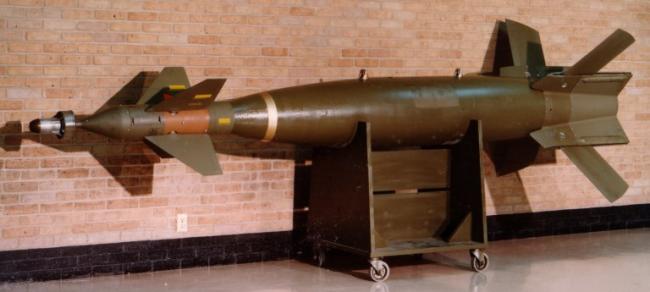 |
| Photo: via Air Power Austrlia |
| GBU-10/B (exact version unknown, either GBU-10C/B, -10D/B or -10E/B) |
Known designations of GBU-10/B and GBU-50/B Paveway II variants include:
| Designation | Warhead | Modification Kit 1 | CCG | Airfoil Group |
|---|---|---|---|---|
| ( GBU-10/B, GBU-10A/B, GBU-10B/B: see Paveway I ) | ||||
| GBU-10C/B | MK 84 or BLU-117/B | KMU-351D/B | MAU-169/B | MXU-651/B |
| GBU-10D/B | KMU-351E/B | MAU-169A/B | ||
| GBU-10E/B | — 2 | MAU-169B/B, D/B or E/B | ||
| GBU-10F/B | MAU-169C/B 3 | |||
| GBU-10G/B | BLU-109( )/B 4 | MAU-169/B | ||
| GBU-10H/B | MAU-169A/B | |||
| GBU-10J/B | MAU-169B/B, D/B or E/B | |||
| GBU-10K/B | MAU-169G/B 3 | |||
| GBU-10( )/B 5 | MK 84 BLU-109( )/B |
MAU-169H/B MAU-169J/B MAU-209( )/B | ||
| GBU-50/B | MK 84 BLU-109( )/B | — | MAU-169K/B | |
Notes:
- The KMU-351( )/B kits consist of the MAU-169( )/B CCG and MXU-651/B airfoil group.
- There are no KMU-351( )/B designations known for GBU-10E/B and later versions. It's possible that KMU-351F/B, -351G/B etc. were assigned, but there is no evidence to back this up. On the other hand, it could be that the KMU nomenclature for complete kits was abandoned at some time, because the only changing component appears to be the CCG.
- The MAU-169C/B and -169G/B (and therefore the GBU-10F/B and -10K/B) were apparently produced in small numbers only or not at all.
- It can be assumed that the USAF uses the BLU-109/B while the U.S. Navy uses the thermally protected BLU-109A/B version.
- It is unclear, which GBU-10( )/B series designations apply to GBU-10s with MAU-169H/B, J/B and MAU-209( )/B CCGs. Most likely no new series letters were assigned, and the all-up rounds are still known as GBU-10E/B and -10J/B for the MK 84 and BLU-109 warheads, respectively.
GBU-12/B, GBU-49/B, GBU-51/B, GBU-52/B, GBU-73/B
The GBU-12/B series covers Paveway I and Paveway II LGBs with warheads in the 500 lb class. The following warheads are used in GBU-12/B series LGBs:
- MK 82: Standard 500 lb LDGP (Low-Drag General Purpose) bomb
- BLU-111/B: In place of the MK 82, the U.S. Navy also uses the BLU-111/B warhead. The BLU-111/B is externally identical to the MK 82, but uses the PBXN-109 thermally insensitive explosive. The BLU-111A/B variant, the version actually used by the Navy, has external protective coating.
The designation series GBU-49(V)/B covers Raytheon Enhanced Paveway II GPS/INS-equipped GBU-12/B variants, which are informally also known as EGBU-12.
The GBU-51/B uses the BLU-126/B LCDB (Low Collateral Damage Bomb) warhead. It is externally identical to the BLU-111( )/B, but is filled with less explosives for a reduced fragmentation pattern blast radius. The LCDB was developed by the U.S. Navy for use in situations where friendly forces and/or civilians are close to the target.
The GBU-12F/B and GBU-52/B are Lockheed Martin DMLGB variants of the GBU-12( )/B and GBU-51/B, respectively.
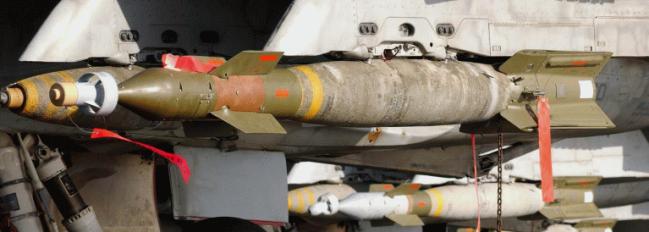 |
| Photo: U.S. Navy |
| GBU-12/B (exact version unknown, either GBU-12B/B, -12C/B or -12D/B) |
The designation GBU-73/B refers to the Lockheed Martin Paragon 500 lb class Paveway II guided bomb. It is an improved version of the GBU-12F/B DMLGB, and was formerly known as the Dual Mode Plus LGB. Compared to the DMLGB, Paragon, which has been in development since at least 2016, has improved optics and a new control actuation system.
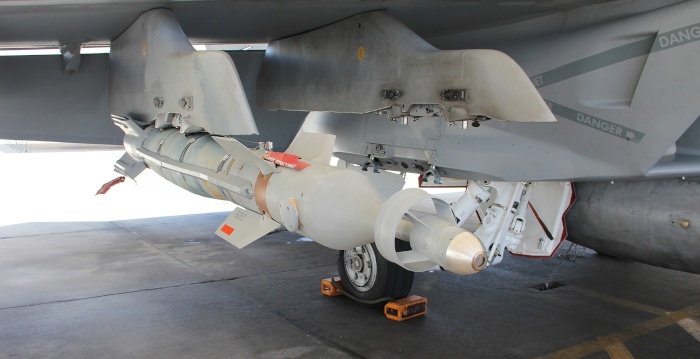 |
| Photo: Lockheed Martin |
| GBU-73/B |
Known designations of GBU-12/B, GBU-49/B, GBU-51/B and GBU-52/B Paveway II variants include:
| Designation | Warhead | Modification Kit 1 | CCG | Airfoil Group |
|---|---|---|---|---|
| ( GBU-12/B, GBU-12A/B: see Paveway I ) | ||||
| GBU-12B/B | MK 82 or BLU-111A/B | KMU-388B/B | MAU-169/B | MXU-650/B |
| GBU-12C/B | KMU-388C/B | MAU-169A/B | ||
| GBU-12D/B | — 2 | MAU-169B/B, D/B or E/B | ||
| GBU-12E/B | MAU-169C/B 3 | |||
| GBU-12F/B | WGU-53/B | — | ||
| GBU-12( )/B 4 | MAU-169H/B MAU-169J/B MAU-209( )/B |
MXU-650/B | ||
| GBU-49(V)1/B 5 GBU-49(V)2/B GBU-49(V)3/B | — | MAU-169K/B | ||
| GBU-51/B | BLU-126/B | — | MAU-169( )/B or -209( )/B | |
| GBU-52/B | WGU-53/B | — | ||
Notes:
- The KMU-388( )/B kits consist of the MAU-169( )/B CCG and MXU-650/B airfoil group.
- There are no KMU-388( )/B designations known for GBU-12D/B and later versions. It's possible that KMU-388D/B, -388E/B etc. were assigned, but there is no evidence to back this up. On the other hand, it could be that the KMU nomenclature for complete kits was abandoned at some time, because the only changing component appears to be the CCG.
- The MAU-169C/B (and therefore the GBU-12E/B) was apparently produced in small numbers only or not at all.
- It is unclear, which GBU-12( )/B series designations apply to GBU-12s with MAU-169H/B, J/B and MAU-209( )/B CCGs. Most likely no new series letters were assigned, and the all-up rounds are still known as GBU-12D/B.
- The GBU-49(V)1/B and (V)2/B variants use laser guidance kits with NATO 192 codes, while the (V)3/B uses a kit with non-NATO codes.
GBU-16/B, GBU-48/B
The GBU-16/B series covers Paveway II LGBs with warheads in the 1000 lb class. The following warheads are used in GBU-16/B series LGBs:
- MK 83: Standard 1000 lb LDGP (Low-Drag General Purpose) bomb
- BLU-110/B: In place of the MK 83, the U.S. Navy also uses the BLU-110/B warhead. The BLU-110/B is externally identical to the MK 83, but uses the PBXN-109 thermally insensitive explosive. The BLU-110A/B and -110B/B variants, which are the ones actually used by the Navy, have external protective coating.
The designation series GBU-48(V)/B covers Raytheon Enhanced Paveway II GPS/INS-equipped GBU-16/B variants, which are informally also known as EGBU-16.
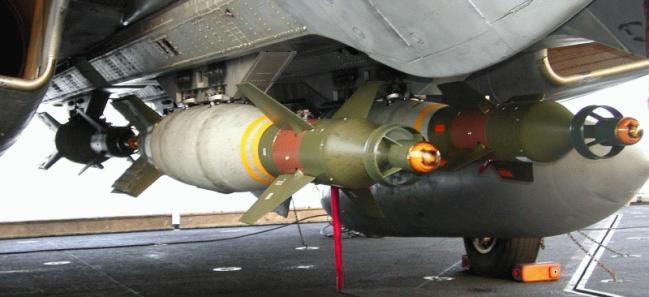 |
| Photo: U.S. Navy |
| GBU-16/B (exact version unknown, either GBU-16/B, -16A/B or -16B/B) |
Known designations of GBU-16/B and GBU-48/B variants include:
| Designation | Warhead | Modification Kit 1 | CCG | Airfoil Group |
|---|---|---|---|---|
| GBU-16/B | MK 83 or BLU-110( )/B | KMU-455/B | MAU-169/B | MXU-667/B |
| GBU-16A/B | — 2 | MAU-169A/B | ||
| GBU-16B/B | MAU-169B/B, D/B or E/B | |||
| GBU-16C/B | MAU-169C/B 3 | |||
| GBU-16( )/B 4 | MAU-169H/B MAU-169J/B MAU-209( )/B | |||
| GBU-48(V)1/B | — | MAU-169K/B |
Notes:
- The KMU-455( )/B kits consist of the MAU-169( )/B CCG and MXU-667/B airfoil group.
- There are no KMU-455( )/B designations known for GBU-16A/B and later versions. It's possible that KMU-455A/B, -455B/B etc. were assigned, but there is no evidence to back this up. On the other hand, it could be that the KMU nomenclature for complete kits was abandoned at some time, because the only changing component appears to be the CCG.
- The MAU-169C/B (and therefore the GBU-16C/B) was apparently produced in small numbers only or not at all.
- It is unclear, which GBU-16( )/B series designations apply to GBU-16s with MAU-169H/B, J/B and MAU-209( )/B CCGs. Most likely no new series letters were assigned, and the all-up rounds are still known as GBU-16B/B.
GBU-17/B
The GBU-17/B was to be a HSM (Hard Structure Munition) penetrator warhead with a Paveway II guidance kit, but this version was not built.
GBU-58/B, GBU-59/B
The GBU-58/B is a Paveway II LGB with a 250 lb MK 81 warhead, and the GBU-59/B is the same warhead with an Enhanced Paveway II GPS/INS guidance kit. The airfoil group of both variants is designated MXU-1006/B.
Inert Paveway II LGBs
The LGTR (Laser Guided Training Round) is an inert cylindrical bomb body of 10 cm (4 in) diameter with a Paveway II guidance kit, and emulates the GBU-10( )/B, GBU-12( )/B and GBU-16( )/B live munitions. It is used by the U.S. Navy for operational Paveway II training to preserve the stockpile of live bombs and their guidance kits. The LGTR comes in several versions, including the BDU-57/B, BDU-59/B, BDU-59A/B, BDU-59B/B, BDU-60/B and BDU-60A/B (the BDU-60( )/B series is usually referred to as LGTR II). Since 1992, Lockheed Martin has delivered more than 50000 LGTRs to the U.S. Navy, and production is continuing.
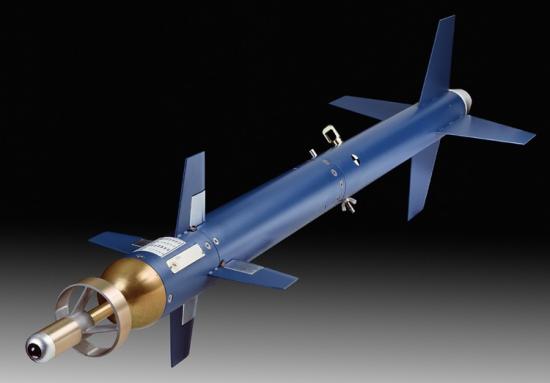 |
| Photo: Lockheed Martin |
| LGTR (exact version unknown) |
During the war in Iraq in 2003, the U.S. Navy reportedly fitted a few concrete-filled BDU-45/B 500 lb dummy bombs with Paveway II guidance kits, and dropped them on selected unprotected urban targets (to prevent the usual high number of civilian casualties when bombing urban terrain). These guided "concrete bombs" were sometimes called "GBU-45", but this is apparently not an official designation.
Specifications
Note: Data given by several sources show slight variations. Figures given below may therefore be inaccurate!
Data for GBU-10E/B, GBU-10J/B, GBU-12B/B, GBU-16/B, LGTR:
| GBU-10E/B | GBU-10J/B | GBU-12B/B | GBU-16/B | LGTR | |
|---|---|---|---|---|---|
| Length | 4.32 m (14 ft 2 in) | 4.24 m (13 ft 11 in) | 3.33 m (10 ft 11 in) | 3.68 m (12 ft 1 in) | 1.90 m (6 ft 3 in) |
| Diameter | 46 cm (18 in) | 37 cm (14.5 in) | 27.3 cm (10.75 in) | 35.6 cm (14 in) | 10 cm (4 in) |
| Fin span | 1.68 m (5 ft 6 in) | 1.34 m (4 ft 4.75 in) | 1.60 m (5 ft 3 in) | ? | |
| Weight | 957 kg (2110 lb) | 966 kg (2130 lb) | 275 kg (606 lb) | 495 kg (1092 lb) | 40 kg (89 lb) |
| Warhead | MK 84 bomb | BLU-109/B | MK 82 bomb | MK 83 bomb | none |
Main Sources
[1] GlobalSecurity.org Website
[2] Raytheon Website
[3] Lockheed Martin Missiles & Fire Control Website
[4] Norman Friedman: "World Naval Weapons Systems, 1997/98", Naval Institute Press, 1997
[5] USAF nomenclature records for GBU series designations
Back to Directory of U.S. Military Rockets and Missiles, Appendix 5
Last Updated: 4 February 2024